Functional Circuit Training in Fitness
Фотографии:
ˑ:
R.M. Saitov, fitness director of spa and fitness club “Wellness Park”
T.S. Lisitskaya, professor, Ph.D.
Russian state university of physical culture, sport, youth and tourism (SCOLIPC), Moscow
Key words: recreational fitness, circuit training, functional training, functional exercises.
Introduction. Effective and adequate selection of means and methods of development of motor qualities, ensuring improved state of health, physical fitness and constitution of people is one of the acute goals of scientists and practitioners who work in the fitness sphere [1, 2, 4, 6].
It is to be marked that very few researches on validation of various fitness methodologies have been carried out in our country. The studies mainly referred to the use of athleticism, traditional methods of aerobics, specifically step aerobics, classic (basic) aerobics and Pilates method [5, 7-10].
Circuit training is the most popular organizational-educational form of classes in sport. It was started to be introduced into the field of fitness not so long ago [15, 16]. Despite the wide use of different types of circuit training in fitness, this organizational-methodological form is poorly validated which makes the issue relevant.
The purpose of the study was to make fitness training in conditions of fitness clubs more effective using integrated circuit trainings which include functional exercises [11, 12] with the use of modern fitness equipment.
Materials and methods. The research methods included courseware analysis, tests of physical qualities, educational experiment and statistical methods. Physical fitness was estimated before and after the experiment using the following tests: 1 - wall squats (hold-on time); 2 - push-ups; 3 - arch back arms locking behind neck (number of reps per 15 sec); 4 - crunch (number of reps per 20 sec); 5 - holding two legs forward sitting with back to the wall; 6 - wall lean pressing sideward (distance from toes to floor - in cm); 7 - passive flexibility in shoulder joints; 8 - forward lean. The states of vegetative nervous (as regulating) and cardiovascular (as regulated) systems were estimated using the Baevsky's method [3].
The study involved members of the fitness club «Wellness Park», the teenage group of the age of 16 to 18 years. The experimental group (n = 25) was engaged in the program of circuit training designed by us, the control group (n = 25) - was exercising using traditional group strength programs. Below is one of the programs, which consisted of three mini-circles with 4 stations on each.
Circle 1. Station 1. Squatting in a wide stance with legs apart with weights in the form of a stuffed bag filled with sand (NARROW SQUAT). Initial position - Legs apart stance, weight in front of the chest. 10-12 reps (photo 1).
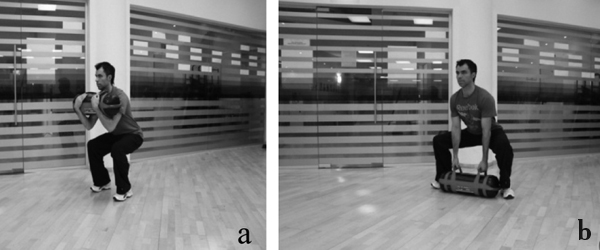
Photo 1. Squatting in a wide stance with legs apart with weights in the form of a stuffed bag filled with sand
Station 2. Torso twists with a stuffed ball in hands. Repetitions tempo is from medium to fast enough, depending on the trainee’s fitness level (photo 2). 10-12 reps in each direction.
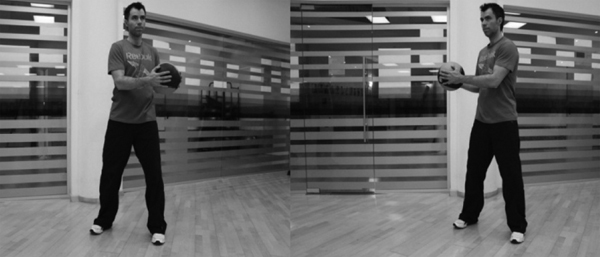
Photo 2. Torso twists with a stuffed ball in hands
Station 3. Lifting a bag over the head from the wide stance squat. The squat is performed with the arms bent (SUMO TOTAL LIFT). 10-12 reps (photo 3)
Station 4. Diagonal swinging movements (DIAGONAL LIFT). Initial position - a lunge with the right leg to the side while turning the torso to the right, med ball is at the bottom.
Straightening up, switch to the left leg, the right leg is behind on the half toes, upward arms swing in an arc to the diagonal. Return to the initial position (photo 4). 8 reps in each direction.
Circle II. Station 1. Initial position - legs apart, med ball below. Circular motions of the ball (photo 5). 4 reps in each direction.
Station 2. Initial position - Prone position with a support on an unstable platform (BOSU). Hops from right to left (photo 6). Duration of the exercise - 60 sec.
Station 3. I.P. - deep squat, arms forward, move to the supine position on an unstable platform BOSU, arms forward, legs bent, feet on the floor (photo 7). 10-12 reps.
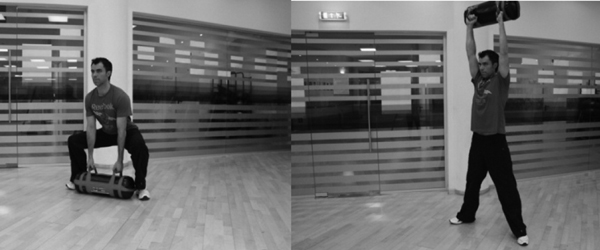
Photo 3. Squat with a jerk lifting of the bag
Station 4. Prone position with the foot support on an inverted hemisphere (BOSU) – “Plank” (photo 8). Hold it for 45 sec.
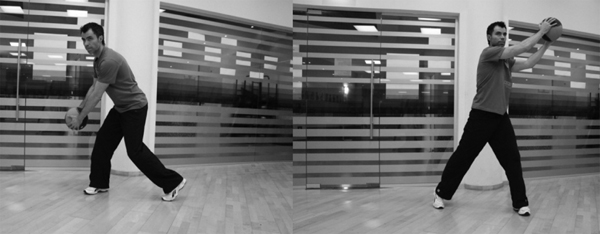
Photo 4. Diagonal movements with a ball
Circle II. Station 1. Initial position - legs apart, med ball below. Circular motions of the ball (photo 5). 4 reps in each direction.

Photo 5. Frontal arm circling with a med ball
Station 2. Initial position - Prone position with a support on an unstable platform (BOSU). Hops from right to left (photo 6). Duration of the exercise - 60 sec.

Photo 6. Lateral hops with a support on an unstable platform (BOSU)
Station 3. I.P. - deep squat, arms forward, move to the supine position on an unstable platform BOSU, arms forward, legs bent, feet on the floor (photo 7). 10-12 reps.

Photo 7. Rolls on an unstable platform BOSU
Station 4. Prone position with the foot support on an inverted hemisphere (BOSU) – “Plank” (photo 8). Hold it for 45 sec.
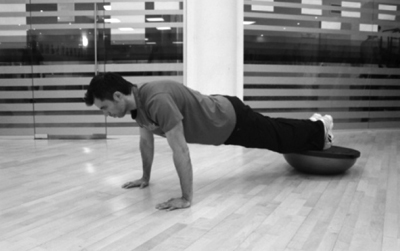
Photo 8. «Plank»
Circle IV. Station 1. Jumps on the right foot forward followed by backward running, then jogging back on the left leg (photo 9). While jumping use your arms actively, perform jumps as far forward as you can on one leg until reaching the last disc, bend the leg during the jump and landing.
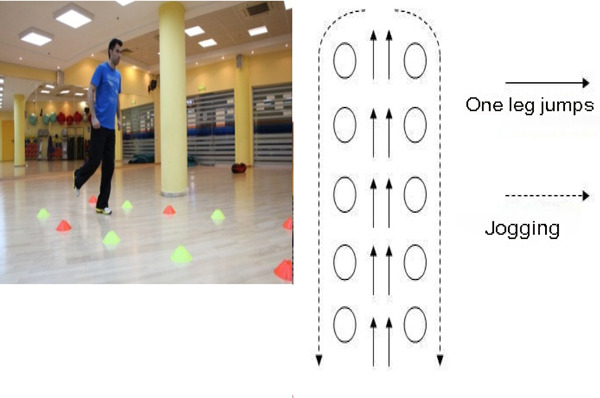
Photo 9. One leg jumps, running back (using 5 disks)
Station 2. Figure 8 running around the first two disks and sprint forward to the end, jogging back lightly.
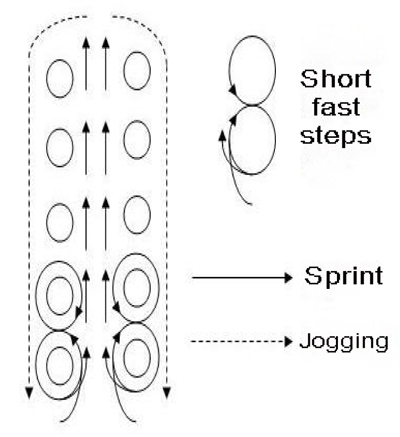
Photo 10. Fast running (5 disks)
Station 3. Lunge-walk. Torso straight, perform lunges starting with heels, knees and feet in the same direction, running back facing forward
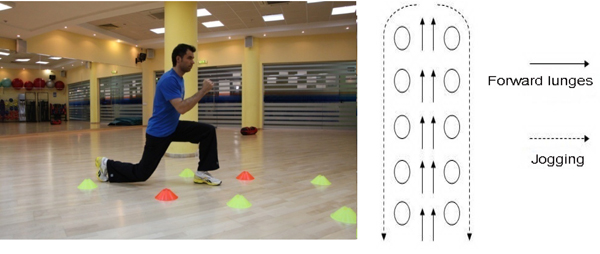
Photo 11. Forward lunges, jogging
Station 4. Prone position pushups on an unstable platform, running in the prone position (8 reps) (photo 12). 4-8 reps.

Photo 12. Running in prone position
With the growth of the fitness level the exercises were performed at each station in 2-3 sets and the number of laps was increased to 3-4.
Results and discussion. The analysis of the intragroup changes for all tests has revealed the positive dynamics during the experiment in both the first and the second groups (Fig. 1). On average the growth for all tests in the first (experimental) group was 84% in the second (control) group - 30%. However, the values were significantly different in different indicators of control exercises. First of all, it relates to the joint mobility and flexibility. Thus, the indicators of the shoulder joint mobility and the mobility of the spinal column changed to a lesser extent in both the first and in the second groups. The differences in the increase in the shoulder joints mobility of the first group (t = 0,58, p> 0,050), and the second group (t = 1,36, p> 0,050) were not statistically significant. The results of the mobility of the spinal column (side bends) as a result of the proposed technique (the first group) had significantly important changes (p <0,01) in contrast to the control (the second) group (p> 0,05), but after the educational experiment the figures of the first and second groups appeared to be not statistically significant (p> 0.05). The most significant positive changes, as a result of the experiment in the first group rather than in the second one, were observed in the indicators of forward bends (the differences were statistically significant p <0,05). Significant changes in both groups were observed in the strength endurance test, measured mainly by the work of quadriceps - test number 1 (p <0,01). At the same time, in a complex test to assess strength endurance of the muscles of the front of the thighs and abdominals (test № 5) the results were materially different: a statistically significant increase in performance (p <0,01) was in the first group before and after the experiment, and a statistically insignificant increase in the second (control) group (p> 0,05). The results of the indicators of the strength and speed qualities of the abdominal muscles were similar to those in the test № 5.
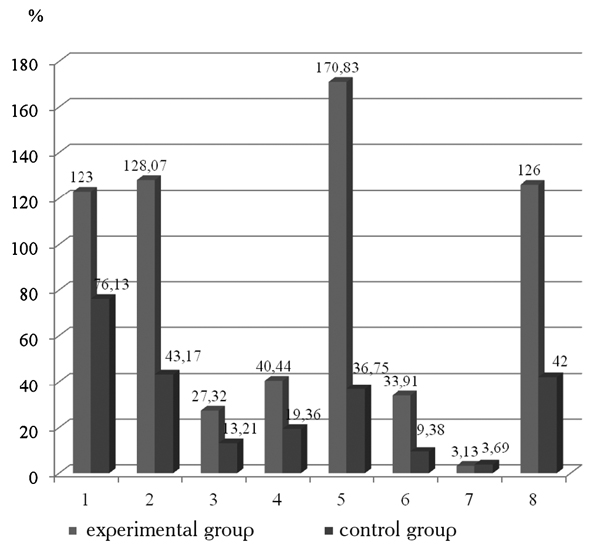
Fig. 1. Changes in physical fitness indicators in the experimental and control groups before and after the experiment, %
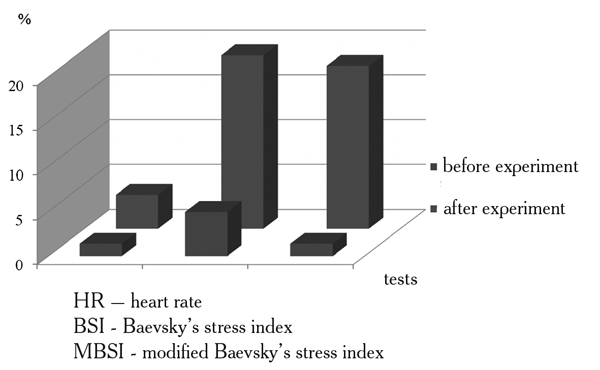
Fig. 2. Changes in the indicators of heart rate and Baevsky’s stress index in the control and the experimental groups before and after the experiment
Statistically significant changes occurred in the experimental group compared to the control group on indicators of BSI (Baevsky’s stress index) (t=2,47, p<0,05) and MBSI (modified Baevsky’s stress index) (t=2,10, p<0,05). As a result of this experiment significant differences were found in the studied indicators of physical fitness. Especially noticeable changes were found in the tests № 1, 5, 8, namely in the strength endurance indicators, assessed by the quadriceps work, in the test № 5, comprehensively evaluating the strength endurance of the muscle of the front of thighs, abdominals and back, as well as in flexibility index (test № 8), which was estimated by using the forward bends. There was a statistically significant increase in the strength indicators in the test for the arms flexion-extension (t=4,22, p<0,01). The performance data indicates greater effectiveness of the proposed functional circuit training as compared with traditional methods in the form of group programs.
Conclusion. Proceeding from the findings, introducing into practice circuit fitness trainings with the use of functional exercises will contribute to the diversification of fitness services and more efficient process of recreation of the population.
References
- Anikienko, Zh.G. The features of the influence of fitness methods on physical fitness, physical development and functional state of girls / Zh.G. Anikienko / Uchenye zapiski universiteta im. P.F. Lesgaft. – 2012. – 10 (92). – P. 10-16. (In Russian)
- Aftimichuk, O.E. Fitness aerobics. Theory and methodology: teaching aid / O.E. Aftimichuk. – SUPhES. – Kishinev: Ch.: Valinex SA, 2011. – 310 P. (In Russian)
- Baevsky, R.M. Estimation of body adaptabilities and risk of disease development / R.M. Baevsky, A.P. Berseneva. – Moscow: Meditsina, 1997. – 265 P. (In Russian)
- Balsevich, V.K. Conversion of the fundamentals of the theory of sports training during physical education / V.K. Balsevich // Teoriya i praktika fizicheskoy kultury. – 1997. – № 6. – P. 15-26. (In Russian)
- Burkova, O.V. The influence of the Pilates system on development of physical qualities, correction of body build and psychoemotional state of middle-aged women: abstract of Ph.D. thesis / O.V. Burkova. – Moscow, 2008 – 24 P. (In Russian)
- Deminsky, A.Ts. Methodological basics of recreational physical culture: teaching aid for physical culture and sport institutes and departments / A.Ts. Seminsky, Zh.K. Kholodov, V.S. Kuznetsov. – Donetsk state institute of health, physical education and sport. – Donetsk. 2001. – 66 P. (In Russian)
- Zhernosek, A.M. Technologies of using step aerobics classes in fitness training: abstract of Ph.D. thesis / A.M. Zhernosek. – Moscow: MSU, 2007. – 24 P. (In Russian)
- Ishanova, O.V. Integrated technology of classes of fitness aerobics with women aged 25-35: abstract of Ph.D. thesis / O.V. Ishanova. – Moscow, 2008 – 24 P. (In Russian)
- Romanova, L.A. Individualization of correction of the morphofunctional state of female students involved in shaping: abstract of Ph.D. thesis / L.A. Romanova. – Chelyabinsk, 2005 – 24 P. (In Russian)
- Solodyanikov, O.V. Technology of step aerobics classes based on biomechanic studies of basic steps: abstract of Ph.D. thesis / O.V. Solodyanikov. – St.Petersburg, 2009. – 24 P. (In Russian)
- Teaching aid for the seminar “Functional group training”. Welcome Wellness company, Moscow, 2013. – 24 P. (In Russian)
- Teaching aid “Functional training. X chart workout AALO company. – Moscow, 2012. – 32 P. (In Russian)
- Borboa, M. Top 10 functional exercises for full-body fitness Health & Wellness Nov 20. – 2008. (In Russian)
- Elvar, J.R.H. Donate, F.I. Medrano, I.C. Ordonez, F.M. Guia de ejercicios de fitness muscular. Bases para un acondicionamiento neuromuscular saludable. Wanceulen tditorial deportiva. 2011. – 135 p.
- Held, Ulli. Tips fuer zirkeltraining/ Meyer&Meyer Verlag. 2000. – 167 s.
- Papi, J.D. Entrenamiento functional en programas de fitness. Vol. 1I. Metodo integrado de entrenamiento para actividades de fitness / salud – Acondicionamiento muscular functional. INDE publicaciones. – 2007. – 232 s.
Author’s contacts: fit fox@mail.ru


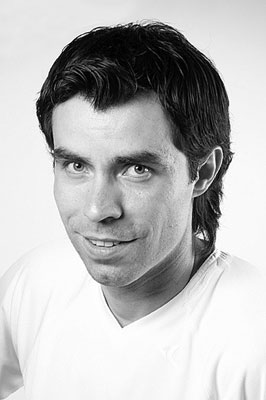

 Журнал "THEORY AND PRACTICE
Журнал "THEORY AND PRACTICE